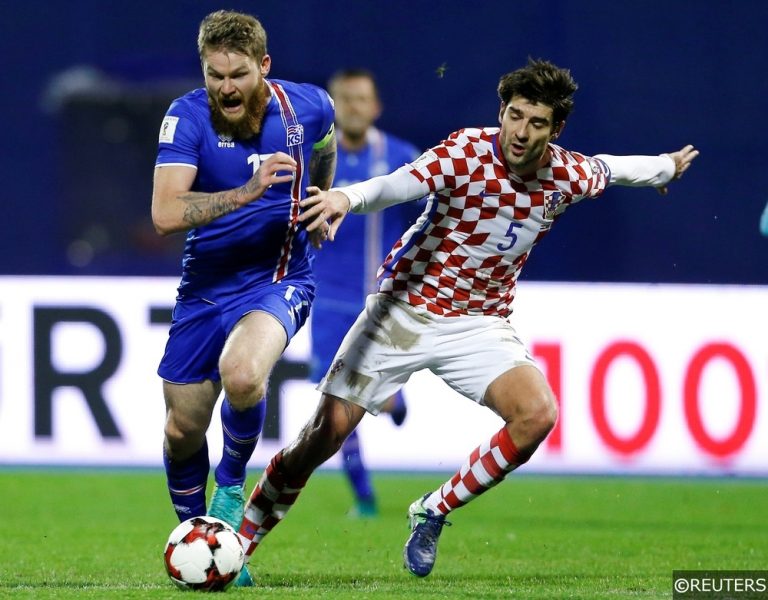
England fans will tell you they know all about the rise of Iceland following the meeting between the nations back at Euro 2016. We take a more in depth look at an Iceland side who will be competing in their first ever World Cup this summer.
In case you missed it, we took a more in depth look at their squad, and some of the other nations representing Europe, here.
Iceland’s Rise
It is funny to think that had Steve Coppell had his way, the jewel of the Iceland’s midfield, Gylfi Sigurdsson, could have been transformed into a centre half. In 2009 a group of young Icelandic football coaches travelled to England to study for their Uefa coaching licences. Whilst in the UK, they stopped at Reading to check on Sigurdsson’s progress. The future star was still coming through the ranks in those days and Coppell thought he was too slow to play in midfield and would be better suited playing further back in the defence. Happily for the modern history of Icelandic football, Brendan Rodgers arrived soon afterwards, took one look and moved him 30 yards up the pitch.
The emergence of stars like Sigurdsson has helped the nation to their most successful spell in their history and Iceland have risen from 131st in the FIFA World Rankings just six years ago to being ranked as the 22nd best international side on the planet.
It is a remarkable success story from a nation with a population of just over 330,000. To give you some perspective, England has a population of just over 53 million people, which those of you who are good at maths will recognise as being around 160 times greater than the Icelanders.
Coaching
The story of Gylfi Sigurdsson may have been moulded largely by his time in England, but the 28-years-old’s talent was obvious even when coming through the youth ranks at FH and Breiðablik. However, for him to even have the opportunity to play football in a nation which has the sort of weather which makes it difficult to have a regular fixture list has to be credited to the Icelandic government and FA.
One of the key contributing factors has been the building of indoor football pitches in recent years in practically every community around the country. This has ensured that practice was not limited to the summer months only, as had been the case for decades.
Secondly, young people are much more willing to put in time on the pitch when the fierce Icelandic weather was no longer able to hamper their enthusiasm. With the increase of young players, more foreign-trained coaches arrived on the scene, bringing more organisation to the practical development of the sport.
From being ranked 131st in the FIFA World Rankings just six years ago, #Iceland head into their first #WorldCup this year ranked just 22nd!
Who sees them as a Dark Horse this year? 🇮🇸🇮🇸 pic.twitter.com/a25srBTUQi
— Football Super Tips (@FootySuperTips) May 30, 2018
Technology
In Iceland, the interest in football has grown exponentially and this is largely down to the improvements in technology. Most of the top leagues in Europe and around the world are available on television or on the internet for Icelanders to enjoy and what was once a fringe sport in the country has grown into one of it’s most watched offerings.
With the increased interest in the sport, comes increased participation and, as already discussed, the growth of places to play the game has also attributed to this. Of course, technology has even been important in a where the games can take place as 3G and 4G pitches have had to be installed around the nation.
Management
Under the expert guidance of Lars Lagerbäck , Iceland climbed over 100 places in six years. The Swede led a footballing revolution in Iceland which culminated in the most successful tournament ever for the Icelanders. Exit to France in the Euro 2016 quarter finals was deemed the perfect way for Lagerbäck to draw his time with the nation to a close and he will go on and lead Norway in Russia this summer.
https://www.youtube.com/watch?v=xwNlM5JEz0g
Now lead by Heimir Hallgrímsson, the team has had to adapt to a new man at the helm ahead of their first ever World Cup. However, it is not as big of a change as you might expect. Hallgrímsson was a key part of the Lagerbäck’s team as he was appointed as the assistant manager back in 2011. Shortly after losing at the play-off stage of the 2014 FIFA World Cup qualification against Croatia, he was promoted to a role as joint manager with Lagerbäck and when the Swede left after Euro 2016, he took the role on a solo basis.
Under his stewardship, the side have gone from strength to strength and he has managed to led the side to 10 wins from the 20 matches he has took charge of so far. The man who is also a fully trained dentist has certainly shown that he belongs on the international stage and his side have obviously reacted to his attention to detail as they saw off the likes of Croatia, Turkey and Ukraine to qualify at the top of their group for this summer’s World Cup.
Players
We have already talked about the qualities of Gylfi Sigurdsson, who is without a doubt the class act, but the Everton man has not played since March with a knee injury. The star man will be doing everything within his power to recover for the nation’s first ever World Cup, but don’t be fooled into thinking Iceland’s World Cup is all about him.
There are other players in the Iceland squad that fans of English football will be aware of as the squad includes Premier League and Championship battlers Johann Berg Gudmundsson of Burnley, Birkir Bjarnason of Aston Villa, Aron Gunnarsson of Cardiff City and Hordur Magnusson of Bristol City.
They also have a wealth of experience in the right areas and the side will be led by captain Aron Einar Gunnarsson, who has 77 caps and is the heart of the Iceland team. Gunnarsson’s never-say-die attitude is crucial, pulling the strings in midfield and allowing Sigurdsson time and space to attack. Centre-backs Ragnar Sigurdsson and Kari Arnason are an important pairing, with keeper Hannes Halldorsson another essential piece in the puzzle.
Follow Free Super Tips on Twitter to stay up to date with our daily tips and predictions or browse more football content on our website:


